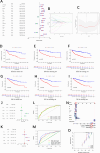AURKB promotes immunogenicity and immune infiltration in clear cell renal cell carcinoma
- PMID: 39014265
- PMCID: PMC11252114
- DOI: 10.1007/s12672-024-01141-7
AURKB promotes immunogenicity and immune infiltration in clear cell renal cell carcinoma
Abstract
Background: Chromatin regulators (CRs) are capable of causing epigenetic alterations, which are significant features of cancer. However, the function of CRs in controlling Clear Cell Renal Cell Carcinoma (ccRCC) is not well understood. This research aims to discover a CRs prognostic signature in ccRCC and to elucidate the roles of CRs-related genes in tumor microenvironment (TME).
Methods: Expression profiles and relevant clinical annotations were retrieved from the Cancer Genome Atlas (TCGA) and UCSC Xena platform for progression-free survival (PFS) data. The R package "limma" was used to identify differentially expressed CRs. A predictive model based on five CRs was developed using LASSO-Cox analysis. The model's predictive power and applicability were validated using K-M curves, ROC curves, nomograms, comparisons with other models, stratified survival analyses, and validation with the ICGC cohort. GO and GSEA analyses were performed to investigate mechanisms differentiating low and high riskScore groups. Immunogenicity was assessed using Tumor Mutational Burden (TMB), immune cell infiltrations were inferred, and immunotherapy was evaluated using immunophenogram analysis and the expression patterns of human leukocyte antigen (HLA) and checkpoint genes. Differentially expressed CRs (DECRs) between low and high riskScore groups were identified using log2|FC|> 1 and FDR < 0.05. AURKB, one of the high-risk DECRs and a component of our prognostic model, was selected for further analysis.
Results: We constructed a 5 CRs signature, which demonstrated a strong capacity to predict survival and greater applicability in ccRCC. Elevated immunogenicity and immune infiltration in the high riskScore group were associated with poor prognosis. Immunotherapy was more effective in the high riskScore group, and certain chemotherapy medications, including cisplatin, docetaxel, bleomycin, and axitinib, had lower IC50 values. Our research shows that AURKB is critical for the immunogenicity and immune infiltration of the high riskScore group.
Conclusion: Our study produced a reliable prognostic prediction model using only 5 CRs. We found that AURKB promotes immunogenicity and immune infiltration. This research provides crucial support for the development of prognostic biomarkers and treatment strategies for ccRCC.
Keywords: Chromatin regulators; Immune therapy; Immunogenicity; Prognostic model; TICs; ccRCC.
© 2024. The Author(s).
Conflict of interest statement
No conflicts of interest are declared by the authors.
Figures








Similar articles
-
Construction and validation of a chromatin regulator-related gene signature for prognostic and therapeutic significance of clear cell renal cell carcinoma.Transl Cancer Res. 2024 Jan 31;13(1):150-172. doi: 10.21037/tcr-23-1383. Epub 2024 Jan 15. Transl Cancer Res. 2024. PMID: 38410230 Free PMC article.
-
Exploration of the relationships between tumor mutation burden with immune infiltrates in clear cell renal cell carcinoma.Ann Transl Med. 2019 Nov;7(22):648. doi: 10.21037/atm.2019.10.84. Ann Transl Med. 2019. PMID: 31930049 Free PMC article.
-
Prediction of overall survival based upon a new ferroptosis-related gene signature in patients with clear cell renal cell carcinoma.World J Surg Oncol. 2022 Apr 14;20(1):120. doi: 10.1186/s12957-022-02555-9. World J Surg Oncol. 2022. PMID: 35422048 Free PMC article.
-
Identification and validation of a gap junction protein related signature for predicting the prognosis of renal clear cell carcinoma.Front Oncol. 2024 Feb 22;14:1354049. doi: 10.3389/fonc.2024.1354049. eCollection 2024. Front Oncol. 2024. PMID: 38454924 Free PMC article.
-
Computational construction of TME-related lncRNAs signature for predicting prognosis and immunotherapy response in clear cell renal cell carcinoma.J Clin Lab Anal. 2022 Aug;36(8):e24582. doi: 10.1002/jcla.24582. Epub 2022 Jul 8. J Clin Lab Anal. 2022. PMID: 35808868 Free PMC article.
References
Grants and funding
LinkOut - more resources
Full Text Sources
Research Materials
Miscellaneous
